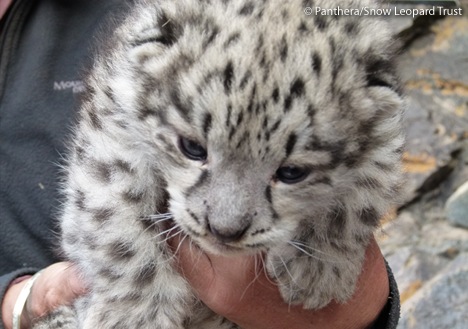Unprecedented footage provides glimpse into the world of young snow leopards
For the first time, the den sites of two female snow leopards and their cubs have been located in Mongolia’s Tost Mountains, with the first known videos taken of a mother and cubs, located and recorded by scientists from Panthera, a wild cat conservation organization, and the Snow Leopard Trust (SLT).
Because of the snow leopard’s secretive and elusive nature, coupled with the extreme and treacherous landscape which they inhabit, dens have been extremely difficult to locate. This is a tremendous discovery and provides invaluable insight into the life story of the snow leopard.
Dr. Tom McCarthy, Executive Director of Panthera’s Snow Leopard Program stated, “We have spent years trying to determine when and where snow leopards give birth, the size of their litters, and the chances a cub has of surviving into adulthood. This is one of those exceptional moments in conservation where after years of effort, we get a rare glimpse into the life of an animal that needs our help in surviving in today’s world. These data will help ensure a future for these incredible animals.”
A short video of the female and her cub who were bedded down in a partially man-made den was recorded from a safe distance by Orjan Johansson, Panthera’s Snow Leopard Field Scientist and Ph.D. student, using a camera fixed to an extended pole.
The team, which included a veterinarian, entered the two dens (the first with two cubs, and the second containing one cub) while the mothers were away hunting. All three cubs were carefully weighed, measured, photographed and other details were recorded. Two of the cubs were fixed with tiny microchip ID tags (the size of a grain of rice) which were placed under their skin for future identification. The utmost care was taken in handling the animals to ensure they were not endangered, which was the top priority of the team at all times. In the following days, the team monitored the mothers’ locations to ensure that they returned to their dens and their cubs, which they successfully did.
“Knowledge about the first days and weeks of life is vital to our understanding of how big cat populations work, and how likely it is for a newborn to reach adulthood and contribute to a healthy population. A valid conservation program requires such information, which this new development in snow leopard research provides,” said Dr. Howard Quigley, Panthera’s Executive Director of both Jaguar and Cougar Programs.
Referred to by locals as ‘Asia’s Mountain Ghost,’ knowledge of snow leopards in general is quite limited due to the cat’s elusive nature, and even less is known about rearing cubs and cub survival in the wild. Until now, what is known has mostly been learned from studying snow leopards in zoos. Although snow leopard litters typically consist of one to three cubs in a captive zoo environment, no information exists regarding litter size in the wild. As wild snow leopard cubs are subject to natural predators, disease, and also human threats such as poaching or capture for the illegal wildlife market, the percentage of cubs which survive to adulthood has until now only been speculated.
The use of PIT tags and observations of snow leopard rearing in the wild will allow our scientists to learn about the characteristics of a typical natal den and speculate how a den is selected, how long snow leopard cubs remain in dens, when cubs begin to follow their mothers outside of the dens, how often and how long the mother leaves the cubs alone to hunt, how many cubs are typically born in the wild, and other valuable data.
All of these data and more, gathered through camera-trapping and GPS collaring, help to inform effective conservation initiatives undertaken by Panthera across the snow leopard’s range.
Source ScienceDaily
Photos Credit Panthera
VIDEO Snow Leopard Cubs In Den
VIDEO Snow Leopard Mother and Cub In Den






Beautiful!!!!!
I do worry about the trekkers etc they seem to be attaching to animals these days .....What happens when they decide they want to cull some ..this means they would be easy to hunt in the hands of the wrong people ... I saw a brief footage of some our wallabys they were talking about culling the poor things had tags in both ears and a collar ...my immediate thought was oh no , what was meant to save the species can also be turned around and used to eliminate some of the species.....
Glorious to see these photographs -- and have thought about the snow leopard ever since 1993, when the director of the main museum in Almaty, Kazakhstan offered me the skins of two snow leopards at $200 a piece. He couldn't believe my questions nor would he admit to being culpable in driving such a rare creature to extinction. I imagine someone did eventually buy them as they had disappeared from the museum shop counter when I next visited.
so beautiful.
One of the most beautiful animals in the world.